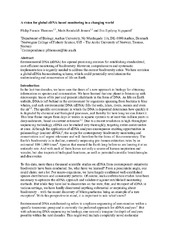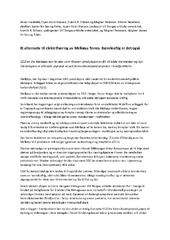Artikler, rapporter og annet (Norges fiskerihøgskole): Recent submissions
Now showing items 21-40 of 1061
-
Allochrony in Atlantic Lumpfish: Genomic and Otolith Shape Divergence Between Spring and Autumn Spawners
(Journal article; Tidsskriftartikkel; Peer reviewed, 2025-02-14)Allochrony is a form of reproductive isolation characterized by differences in the timing of spawning and may play a crucial role in the genetic and phenotypic divergence within species. The Atlantic lumpfish (Cyclopterus lumpus) is known to spawn in spring and autumn. However, the role of allochrony on the genomic structure of this species has not been addressed. Here, by combining whole ... -
Short-term evolutionary implications of an introgressed size-determining supergene in a vulnerable population
(Journal article; Tidsskriftartikkel; Peer reviewed, 2025-01-27)The Thorny Skate (Amblyraja radiata) is a vulnerable species displaying a discrete size-polymorphism in the northwest Atlantic Ocean (NWA). We conducted whole genome sequencing of samples collected across its range. Genetic diversity was similar at all sampled sites, but we discovered a ~ 31 megabase bi-allelic supergene associated with the size polymorphism, with the larger size allele having ... -
Morphological evidence supports splitting of species in the North Atlantic Sebastes spp. complex
(Journal article; Tidsskriftartikkel; Peer reviewed, 2025-02-06)The redfishes (genus Sebastes) are long-lived, commercial species in the North Atlantic. Excessive harvest through decades has led to a decline in the mature population of golden redfish (Sebastes norvegicus) in Norwegian waters, which is currently considered severely depleted. Accumulating genetic evidence suggests a more complex structure within this genus in the North Atlantic, which has ... -
A photonic sensor system for real-time monitoring of turbidity changes in aquaculture
(Journal article; Tidsskriftartikkel; Peer reviewed, 2024-10-08)Objective - The objective of this study was to test the compatibility and performance of a developed photonic sensor system, which can serve as a dependable and practical device for continuous monitoring of turbidity changes in aquaculture tanks.<p> <p>Methods - The fabricated photonic sensor system consisted of an integrated data logger and sensor probe. The sensor probe exhibited a precise ... -
Preferences for Intuition and Deliberation in Decision-Making in the Public Sector: Cross-Cultural Comparison of China, Taiwan, the Philippines, and the USA
(Journal article; Tidsskriftartikkel; Peer reviewed, 2024-02-12)This paper explores hypotheses based on Hofstede’s cultural framework showing that decision-makers’ culture impacts their implicit choice. How people make decisions is tested through the behavioral dimension preference for intuition/preference for deliberation based on data from 1,233 employees in China, Taiwan, the Philippines, and the USA. This study reveals significant variation in individuals’ ... -
A fishy gut feeling – current knowledge on gut microbiota in teleosts
(Journal article; Tidsskriftartikkel; Peer reviewed, 2025-01-10)The importance of the gastrointestinal microbiota (GM) in health and disease is widely recognized. Although less is known in fish than in mammals, advances in molecular techniques, such as 16S rRNA sequencing, have facilitated characterization of fish GM, comprising resident autochthonous and transient allochthonous bacteria. The microbial diversity and composition are strongly influenced by diet. ... -
Five millennia of mitonuclear discordance in Atlantic bluefin tuna identified using ancient DNA
(Journal article; Tidsskriftartikkel; Peer reviewed, 2025-02-07)Mitonuclear discordance between species is readily documented in marine fishes. Such discordance may either be the result of past natural phenomena or the result of recent introgression from previously seperated species after shifts in their spatial distributions. Using ancient DNA spanning five millennia, we here investigate the long-term presence of Pacific bluefin tuna (Thunnus orientalis) and ... -
A vision for global eDNA-based monitoring in a changing world
(Journal article; Tidsskriftartikkel; Peer reviewed, 2024-05-15)Environmental DNA (eDNA) has opened promising avenues for establishing standardized, cost-efficient monitoring of biodiversity. However, comprehensive and systematic implementation is urgently needed to address the current biodiversity crisis. Here, we envision a global eDNA biomonitoring scheme, which could potentially revolutionize the understanding and conservation of life on Earth. -
Metabolomics-Guided Discovery of Bipolarolides H−O, New Ophiobolin-Type Sesterterpenes with Antibacterial Activity from the Marine-Derived Fungus Uzbekistanica storfjordensis sp. nov.
(Journal article; Tidsskriftartikkel; Peer reviewed, 2025-01-30)A marine-derived Pleosporales fungus, Uzbekistanica storfjordensis, was isolated from driftwood and described as a new species. The fungus was cultivated in liquid media and a molecular networking-driven approach was used to identify potential new secondary metabolites. The targeted compounds were isolated using preparative HPLC-MS, and through extensive spectroscopic analysis, eight new ophiobolin-type ... -
Effect of mesh size in monofilament and multifilament gillnets on catch efficiency in the Black Sea whiting (Merlangius merlangus) fishery
(Journal article; Tidsskriftartikkel; Peer reviewed, 2024-02-26)Gillnets are widely used fishing gear for targeting various fish species. Gillnet fisheries use different gear configurations such as different mesh sizes and number of netting twines (mono- or multifilament) depending on the species targeted. Gillnet fishery targeting whiting (Merlangius merlangus) is one of the economically important year-round fisheries in the Black Sea. However, large bycatch ... -
Use of floated gillnet to reduce flatfish bycatch in a mixed-species gillnet fishery
(Journal article; Tidsskriftartikkel; Peer reviewed, 2024-05-24)Bycatch of threatened flatfish species is a major concern in mixed-species bottom-set gillnet fisheries in the Yellow Sea, China. Therefore, we tested floated gillnets against standard bottom-set gillnets to reduce bycatch by exploiting difference in species-specific fish behavior. Our results demonstrated that the floated gillnet design can greatly improve species and size selectivity. Floated ... -
Semi-pelagic trawling in the U.S. West Coast groundfish bottom trawl fishery: Effects on catch efficiency and seafloor interactions
(Journal article; Tidsskriftartikkel; Peer reviewed, 2024-07-15)Reducing the impacts of bottom trawling on seafloor habitats is a management priority in the U.S. West Coast groundfish bottom trawl fishery as well as other trawl fisheries internationally. Modifications to conventional bottom trawls, such as semi-pelagic trawl technology, are commonly used in demersal fisheries to reduce trawl-seafloor interactions by elevating the doors and portions of the sweeps ... -
Et alternativ til elektrifisering av Melkøya finnes. Bærekraftig er det også
(Chronicle; Kronikk, 2025-01-02)CO2-en fra Melkøya kan brukes som råvare i produksjon av fôr til både mennesker og dyr. Teknologien er allerede utprøvd ut ved ferrosilisiumproduksjonen i Finnfjordbotn. -
Extracellular traps in skin lesions infected with lymphocystis disease virus in black rockfish (Sebastes schlegelii)
(Journal article; Tidsskriftartikkel; Peer reviewed, 2024-05-18)The lymphocystis disease (LCD), caused by Lymphocystis disease virus (LCDV), is a benign and self-limiting disease described in a many freshwater and marine fish species. Hypertrophic fibroblasts and extensive aggregation of inflammatory cells are characteristics of LCD. In the present study, small animal imaging and ultrastructural investigations were carried out on the lymphocystis nodules of black ... -
Effects of prolonged application of peracetic acid-based disinfectant on recirculating aquaculture systems stocked with Atlantic salmon parr
(Journal article; Tidsskriftartikkel; Peer reviewed, 2024-06-07)The use of recirculating aquaculture systems (RAS) for Atlantic salmon (Salmo salar) production has become increasingly common. RAS water disinfection plays a crucial role on its biosecurity. Peracetic acid (PAA) is a promising disinfectant due to its powerful oxidative properties, broad antimicrobial spectrum, and rapid degradation into no harmful compounds. This study focused on assessing the ... -
Ontogeny of myeloperoxidase (MPO) positive cells in flounder (Paralichthys olivaceus)
(Journal article; Tidsskriftartikkel; Peer reviewed, 2024-04-10)Neutrophils represent an important asset of innate immunity. Neutrophils express myeloperoxidase (MPO) which is a heme-containing peroxidase involved in microbial killing. In this study, by using real-time quantitative PCR and Western blot analysis, the flounder MPO (PoMPO) was observed to be highly expressed in the head kidney, followed by spleen, gill, and intestine during ontogeny – during ... -
Satisfying Norwegian appetites: Decoding regional demand for shrimp
(Journal article; Tidsskriftartikkel; Peer reviewed, 2024-07-25)This study investigates the regional demand for shrimp in Norway by employing the linear approximated Almost Ideal Demand System (LA/AIDS) framework. Shrimp consumption has grown significantly globally, with Norway being no exception. The LA/AIDS model allows us to examine the demand of shrimp across different regions in Norway. We utilize comprehensive data on regional shrimp consumption, prices, ... -
Giant viruses inhibit superinfection by downregulating phagocytosis in Acanthamoeba
(Journal article; Tidsskriftartikkel; Peer reviewed, 2024-09-03)In the context of the virosphere, viral particles can compete for host cells. In this scenario, some viruses block the entry of exogenous virions upon infecting a cell, a phenomenon known as superinfection inhibition. The molecular mechanisms associated with superinfection inhibition vary depending on the viral species and the host, but generally, blocking superinfection ensures the genetic supremacy ... -
Adjuvant effects of β-defensin on DNA vaccine OmpC against edwardsiellosis in flounder (Paralichthys olivaceus)
(Journal article; Tidsskriftartikkel; Peer reviewed, 2024-03-11)β-defensin of flounder plays an important role in immunomodulation by recruiting immune cells and has a potential vaccine adjuvant effect in addition to its bactericidal activity. In this study, adjuvant effects of β-defensin on DNA vaccine OmpC against edwardsiellosis in flounder (Paralichthys olivaceus) were investigated. The bicistronic eukaryotic expression plasmid pBudCE4.1 plasmid vector with ... -
Implementing the water-energy-food nexus approach to create synergies and reduce tradeoffs between the Sustainable Development Goals
(Journal article; Tidsskriftartikkel; Peer reviewed, 2024-03-11)The Food-Energy-Water nexus approach to resource governance is a paradigmshifting approach that moves away from “siloed” resource management and pursues integration and holistic planning between food, energy, and water governance. The Food-Energy-Water nexus approach carries the potential to increase synergies and reduce tradeoffs between the Sustainable Development Goals. However, theoretical ...


 English
English norsk
norsk


















